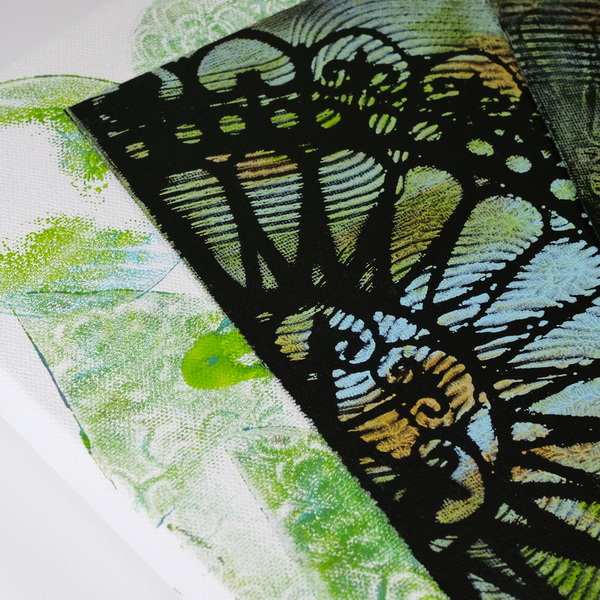
How to Gelli Print on Canvas
Have you ever tried gelli printing on surfaces other than paper? This summer I’ve been playing around with different surfaces with my gel plate to see what interesting results I’ll get. My newest experiment was how to Gelli print on canvas and I’ve been surprised by the results.
Hop-A-Long Studio is reader-supported. When you buy through links on our site, we may earn an affiliate commission at no cost to you. Learn more.
Types of Canvas for Gelli Printing
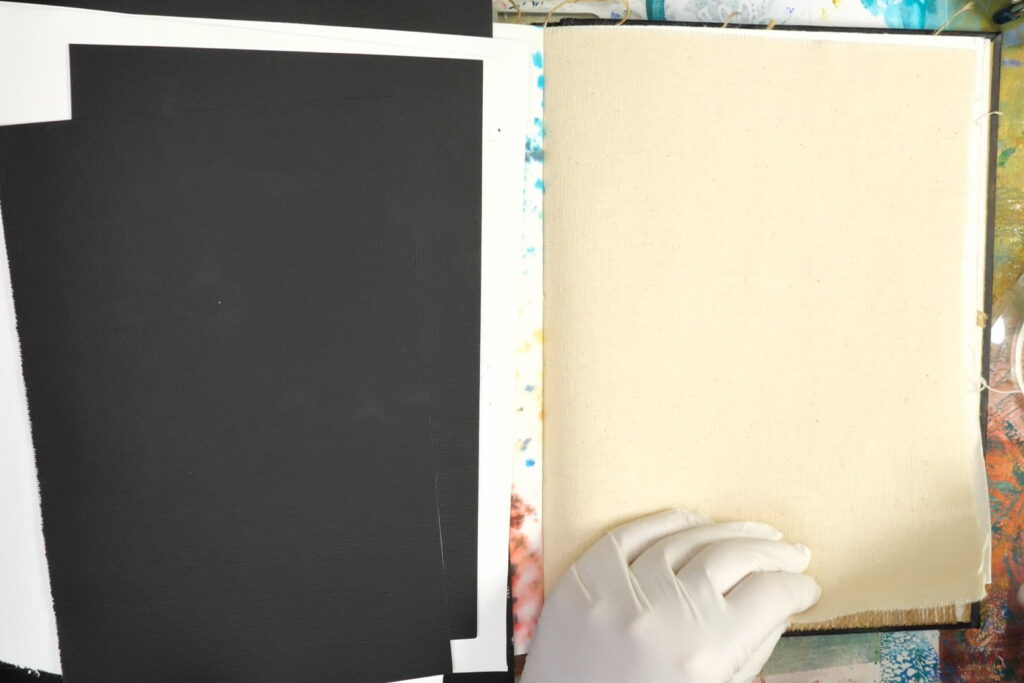
There is a variety of canvas that can be used for Gelli printing. My favorite canvas is artist canvas pads in black and white. These pads are easy to use as the canvas has been primed for paint and each sheet can be torn out of the pad and cut down to size.
Another option for primed canvas is canvas that has been stretched onto a frame or board. These can also work for gelli printing.
You can also use unprimed canvas with the gel plate. Unprimed canvas is floppy and is slightly translucent as it is woven. This can be an very interesting surface to use for gelli printing. For this demonstration I’m using a Dina Wakley Media journal. This journal has a variety of surfaces including unprimed canvas pages.
How to Gelli Print on Primed Canvas
Gelli printing on canvas is not much different than gel printing on paper. You will add paint to your gelli plate and use mark making, stamps, stencils, or objects to add patterns to the surface. But there’s a few things to consider when taking prints to get great results.
Adding More Paint to the Gel Plate

When gel printing on paper, I tend to use a very thin layer of paint to take the prints. As the surface of the primed canvas has tooth, the paint will stick to the gesso. But the paint doesn’t absorb into the surface the way it does with paper. Because of this, depending on the type of print you want, you will need to adjust how much paint you add to the surface.
Puckered and Textured Surfaces
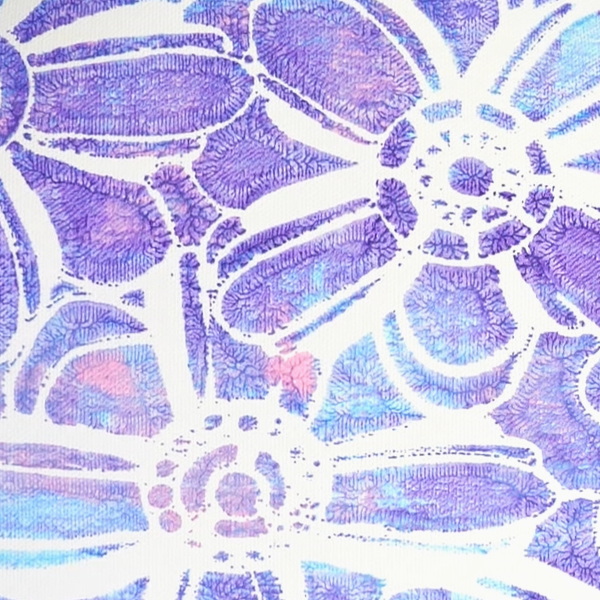
If you want a more puckered and textured surface like this, you will need to add more paint to the surface. This will give you more solid areas of color and interesting puckered and textured surfaces on the canvas.
Canvas Textured Surface
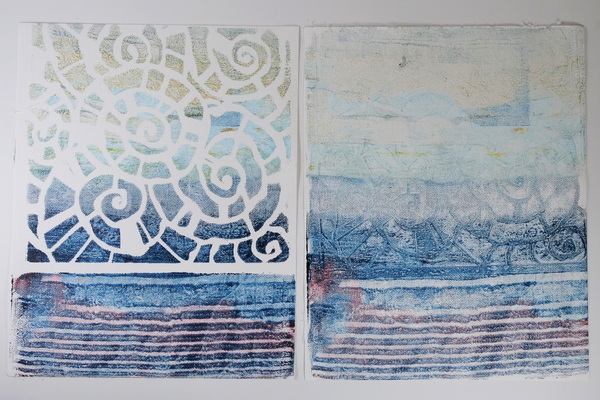
For a strong canvas texture to the surface, add a lighter coat of paint on the surface. By adding less paint, you will see more of the canvas texture come through the print.
Creative Tip: Take the second print with mixed media or copy paper. As the canvas will imprint texture into the gel plate, this beautiful canvas texture will show up in your paper print.
Contrasting Colors
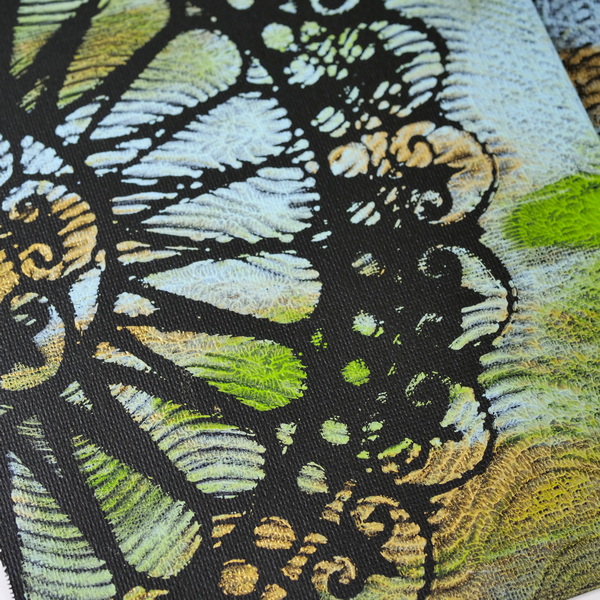
Because of the properties of canvas, the canvas prints will always be lighter than prints created on paper. To get consistent results, use contrasting and vibrant colors. On white canvas, use darker colors. On black canvas, pale and pastel hues work the best for getting beautiful prints.
Choosing Bold Textures
Because of the nature of the canvas and the texture of the surface, use much bolder imagery to get contrasting prints. I tend to leave my stencils on the surface when I make a gelli print on canvas to make sure that I get solid and beautiful final image.
Printing on Unprimed Canvas
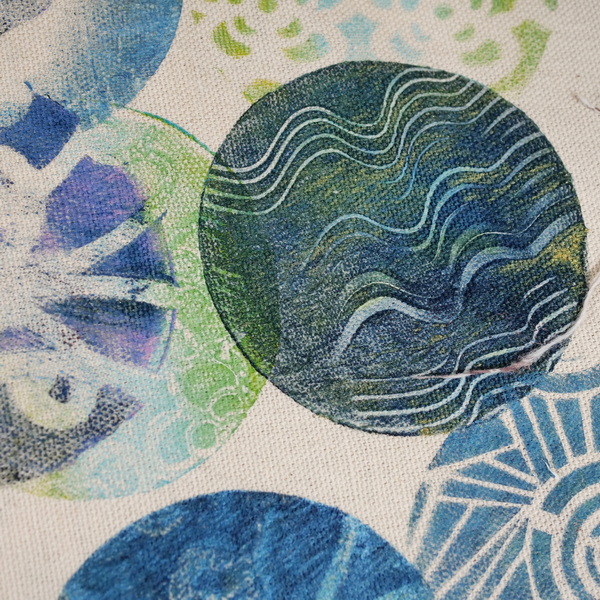
When learning how to gel print on canvas, it’s important to realize that unprimed canvas creates a very different result from primed canvas. Unprimed canvas acts more like cloth or paper, it’s woven and doesn’t have a solid surface. This means that it will absorb a lot of paint and will sometimes soak through the canvas.
I tried this using unprimed canvas with both Gel Press Mini Gel Circle Plate and a full sized Gelli Arts 8×10 Plate. As the unprimed canvas was in my journal, I had to adjust my technique a bit to get consistent results on an uneven surface.
Gelli Printing in an Art Journal
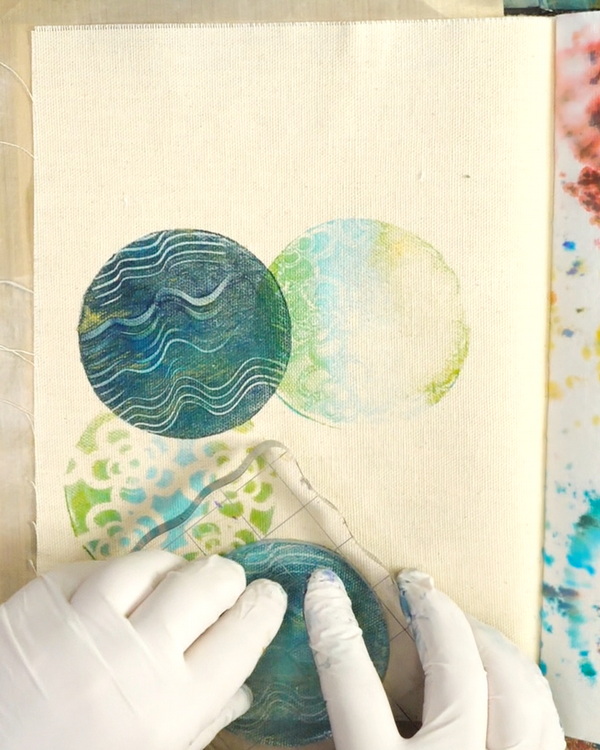
When gelli printing on an art journal with mini plates, if the surface is uneven, you won’t get an even print.
To get an even print, try using mini plates on a stamping block. It works best to find a block barely bigger than your plate. This will help you get into tight areas and still get a good print. You might also want to put a board or hard surface behind the unprimed canvas to create a more even surface.
When you print on unprimed canvas, the print will be less colorful and less contrasting than on white paper. The unprimed canvas will absorb the paint and soften the look of the print because of the nature of the canvas.
Using Full Sized Gelli Prints in the Art Journal

If you want to do a full-page gel print with an 8×10 Gelli plate, you will need to add your plate and designs to the gel plate. Line up the gel plate to the canvas and flip it upside down onto the journal page. This takes practice to get a good image, but it’s a way of getting a print into your book.
The other option is to flip your book upside down but be very careful when lining it up to make sure that you get a good image.
Gelli Printing on Stretched Canvas
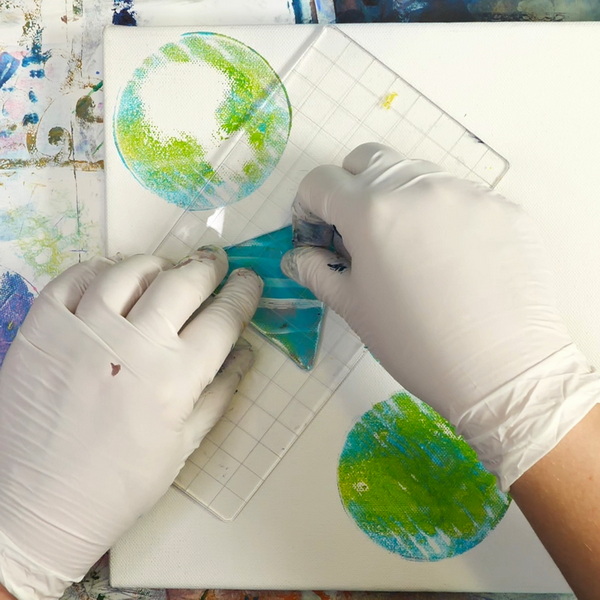
Gelli printing on stretched canvas is possible, but I find the results inconsistent. Stretched canvas has bounce, or flex, to the surface. This is nice when acrylic painting with brushes but doesn’t work as well with the gel plate.
I found that most of my gel prints on canvas had white areas and uneven spaces in the print. This is due to the flex in the canvas. I tried putting my hand in behind the canvas to support the surface, but I find that often it blurs the image.
Another option is to flip the canvas onto the Gelli plate, but this works best with Gelli prints the size of the canvas.
Breaking Up the Background
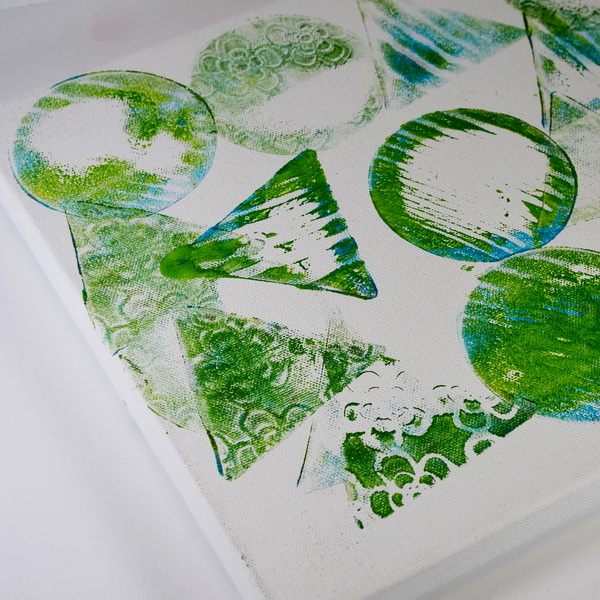
As I was having trouble getting consistent prints, I didn’t fight the process. I decided to use the gel plate to break up the background on my canvas.
If you are unfamiliar with this practice, check out this article. I share several techniques that I use to break up the background of my art journal pages. I also use this technique on canvas projects.
Alternative Techniques to Gelli Printing on Canvas
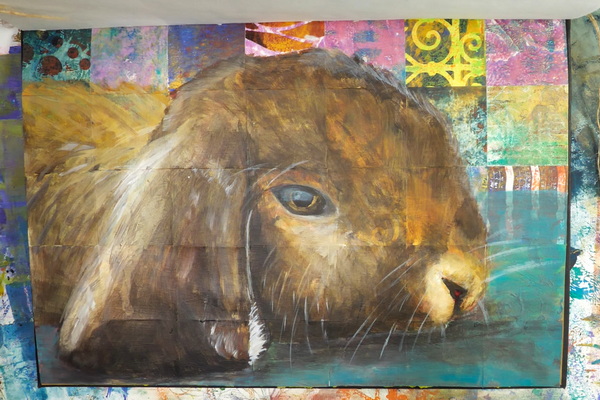
It’s fun to experiment with different surfaces, but my preference is to collage onto my canvases. I like the look of paper and tissue paper gelli prints and it’s easy to add them to my canvases. It also creates more consistent results. But I wanted to share with you another technique other than collaging onto a canvas surface.
Thoughts and Questions?
Any thoughts or questions about how to gelli print on canvas? Have you tried using surfaces other than paper for gelli printing before? If so, I’d love to hear how it worked out for you and how you’ve added it to your projects. Please leave a comment below and I’d love to start a conversation with you!
Project Supply List
Gelli Arts Printing Plate 8×10
Gel Press Mini Printing Plate Circle
Fredrix Artist Canvas Pad White
Fredrix Artist Canvas Pad Black
Dina Wakley Media Journal
Stretched Canvas
Pebeo Studio Acrylic Paints: Iridescent Gold, Turquoise, Terra Rossa, Titanium Buff
Cheep Paints Permanent Violet, Crimson
Amsterdam Standard Series Acrylic Paints Sky Blue Light, Azo Yellow Deep, Quinacridone Rose Lt, Prussian Blue Phthalo, Yellowish Green
Small Brayer
Large Brayer
Art Alternatives Mark Making Tools
Studiolight Mindful Moodling Lovely Florals
Studiolight Mindful Moodling Swirly
Wild Whisper Designs Fanciful Blossom Stencil
TCW Stencil 323
Wood Grain Texture Tool
Stamping Block
Homemade Stencil
Mixed Media Paper



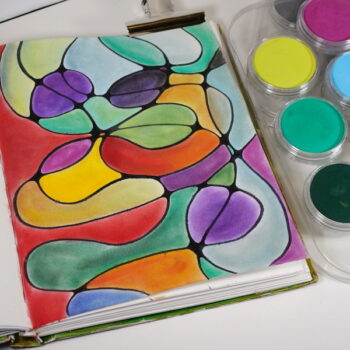
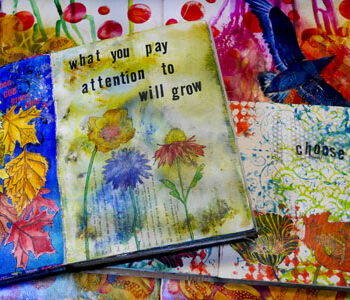
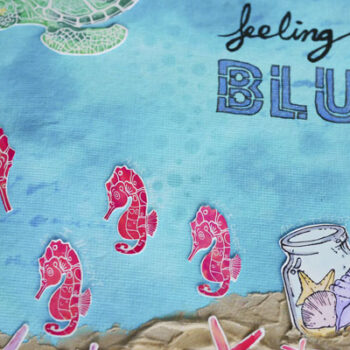
2 Comments
Christinav
Love your ideas and creations! Quick question how do you store your Gelli plate? I was told to keep it in the original clam shell without the plastic and inetween copy paper. Thanks!
Nadine Milton
Thank you so much! I use the original clamshell and keep it between the sheets of plastic. Sometimes you can get bubbles between the Gelli plate and the plastic, but I just smooth them out with my hand. I tend to store them flat and make sure that nothing heavy is put on top of them. I used to store them in a bookshelf but ran into issues with them getting squished and getting indentations on the plate. I’ve had my Gelli plates for around 8 years and haven’t had to replace one yet!